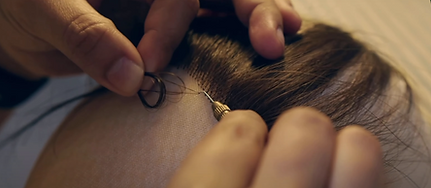Vietnamese Hair Characteristics and Handcrafted HHAIR™ Products by High-skilled Artisans
- Jun 18, 2025
- 767
The hand-sewing of hair wigs and caps by Vietnamese artisans is a highly skilled, meticulous, and labor-intensive craft, often passed down through generations. It results in products renowned for their natural appearance, comfort, and durability.
Preparation of the Cap Base (The Foundation):
- Material Selection: The foundation, or cap, can be made from various materials like fine lace (Swiss, French), monofilament, silk top, polyurethane (PU), or a combination. The choice depends on the desired look (e.g., undetectable hairline, scalp illusion) and wearer's needs (e.g., breathability, adhesion).
- Pattern Making & Sizing: A precise head measurement or a custom mold is used to create a pattern. The cap material is then cut and expertly stitched together, often by hand or with specialized sewing machines, to form the base. This base must fit snugly and comfortably. For full lace wigs, the entire cap is made of lace.
Hair Preparation:
-
Sourcing:
Artisans often work with high-quality human hair (e.g., Remy hair, where cuticles are aligned to prevent tangling). This hair might be sourced locally or imported. -
Sorting & Cleaning:
The hair is sorted by length, texture, and color. It's then meticulously washed, conditioned, and sometimes dyed or processed to achieve the desired shade and feel. -
Hackling/Drawing:
Hair is drawn through a hackle (a bed of needles) to align the strands, remove shorter hairs, and ensure all cuticles are facing the same direction.
Ventilation (The Art of Hand-Tying):
This is the most crucial and time-consuming part, where individual hair strands are attached to the cap base.
Tools The primary tool is a "ventilating needle," which is a tiny hook, similar to a miniature crochet hook. Different needle sizes are used for tying different numbers of strands. The cap is secured tightly on a wig block or mannequin head.
Technique
- The artisan takes a few strands of hair (sometimes just one for very fine hairlines).
- They insert the ventilating needle through the mesh of the lace or other cap material from the underside.
- The needle hooks the hair strands.
- The artisan pulls the hair through the hole, creating a tiny loop, and then skillfully ties a knot (e.g., single knot, double knot, split knot) to secure the hair to the base. Single knots are smaller and less detectable, often used at the hairline. Double knots are more secure.
Direction and Density: This is where true artistry comes in. Artisans meticulously tie hairs to mimic natural hair growth patterns, including the direction of hair growth, swirls at the crown, and natural density variations (e.g., finer and less dense at the hairline, gradually increasing).
Baby Hairs: For an ultra-realistic hairline, finer, shorter hairs ("baby hairs") are often ventilated around the perimeter.
Parting Area:: Special attention is given to the parting area, often using techniques like silk tops or specific knotting methods to create the illusion of hair growing directly from the scalp.
Knot Treatment (Optional but Common):
-
Bleaching Knots
Especially on lace wigs, the tiny knots can be visible. Artisans might carefully bleach these knots (particularly for darker hair on lighter lace) to make them less detectable, further enhancing the illusion of hair growing from the scalp. This requires great precision to avoid bleaching the hair shaft itself. -
Sealing Knots
A sealant might be applied to the underside of the cap to further secure the knots and reduce shedding.
Finishing and Styling:
- Trimming and Shaping: Once all the hair is ventilated, the wig is trimmed, cut, and styled. This might be a basic cut, leaving final styling to the wearer or a professional stylist, or it can be a more complete style.
- Adding Features: Clips, combs, or adjustable straps might be sewn into the cap for a more secure fit.
- Quality Control: The finished wig or cap is thoroughly inspected for any flaws, ensuring even density, secure knots, and overall quality.
Why Vietnamese Artisans are Renowned
- Patience and Dexterity: The process demands incredible patience, a steady hand, and sharp eyesight.
- Tradition of Craftsmanship: Many artisans come from families or villages with a long history of textile or craft work, including wig-making.
- Attention to Detail: The ability to create natural-looking hairlines, partings, and density is a hallmark of their work.
- Cost-Effectiveness: Historically, Vietnam has offered a skilled labor force at competitive prices, making high-quality hand-tied wigs more accessible.
A single hand-tied wig can take an artisan anywhere from 40 to over 200 hours to complete, depending on the length, density, cap construction, and complexity. This dedication results in a premium product that is virtually indistinguishable from natural hair.

 Virtual Try-On
Virtual Try-On
 Analysis
Analysis
 Enhances
Enhances
 Style-Lab
Style-Lab













Discussion
Add comment